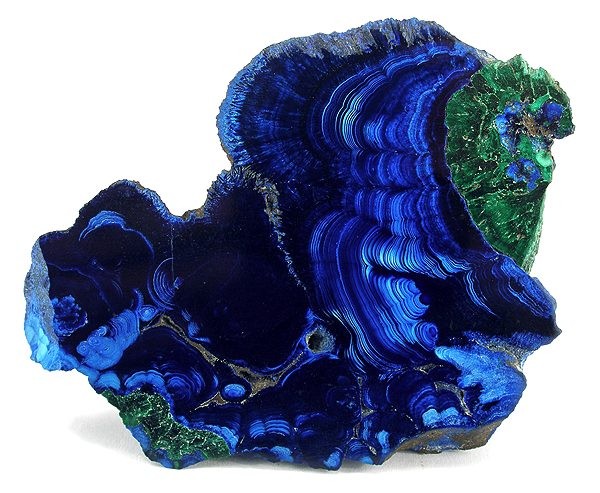By Bill Shelton
Recently, we held a class on the two species listed above – apparently a few people thought it was a good lesson and would like a short review of the highlights on the website for TGMS.
I think the associated species are worth knowing about and please note six are found with both azurite and malachite. They are cuprite, tenorite, calcite, chrysocolla, copper and wad – all according to Dana texts we consulted. Azurite also may be seen with Fe oxides and chalcedony. Malachite may come with chalcocite or limonite. Of course, there are others but these are perhaps the most common and well-documented associates. We also find pseudomorphs are commonly noted and for azurite we include azurite after cuprite, cerussite, tetrahedrite and gypsum. In the case of malachite, it is noted to replace azurite and cuprite. There are others as well but they are probably less common or widely known than the examples given.
Chemistry is one good way to compare minerals and here we find a great deal of similarity – they are both basic cupric carbonates. For your own benefit, take a look at the formulas on mindat.org or in your favorite textbook. While azurite has 69.2% CuO, malachite has 71.9%CuO – a minor difference. Malachite has, upon chemical testing, shown to contain occasional traces of zinc. Azurite is in contrast, ordinarily quite pure.
Because of this, you may expect the properties to be even more similar than they are – the actual results may be a bit surprising.
Clarity is dissimilar in that azurite is transparent to translucent while malachite is translucent to opaque. This will best describe the majority of samples one may encounter – exceptional examples may be good additions to your collection. Crystals of malachite are rare and almost always twins. Azurite, on the other hand tends to be common as crystals and here twins are rare. Color is quite different and azurite is azure blue to very dark blue. Most malachite is a bright green and may also be deeper shades that approach black which will sometimes be seen in banded pieces and also on crystals when they are found. Micro size crystals are noted to be green and transparent but such material is not usually seen. Malachite is also likely to be massive and can be botryoidal in form. Azurite is often in crystals but botryoidal and stalactitic forms occur as well.
Using mindat.org, I found that malachite has 5,478 photos and 11,798 localities. Azurite has 6,274 photos and 5,340 localities. An area of controversy concerns the type locality for azurite – some claim it to be Chessy, France but I am inclined to say there is no type locality because, as it says for malachite, it was known since antiquity. You should look at the lists for the localities given on mindat.org – there is a lot of valuable data here.
According to Minerals and their localities (2015) malachite is “a very common oxidation product of chalcopyrite and other secondary Cu sulfides occurring with azurite and some other secondary Cu minerals in gossan. It is widespread throughout the world”. Azurite is a “very abundant product of oxidation of Cu sulfides and it nearly always accompanies malachite. The Handbook of mineralogy lists aggregates to 9 cm and exhibiting several forms (maybe 20 or so) for malachite. They list crystals to 30 cm for azurite with typically complex crystals and over 100 forms. You should look at the Mineralogy of Arizona for the long lists that they contain – you will find a lot of places for both species on a county by county basis.
We do not make a huge effort to cover gem data but it seemed appropriate to do so and chose several sources. First, the Color encyclopedia of gemstones, where we find azurite as a source of rare faceted stones, mostly less than a carat but cabochons may be up to several inches. Malachite is virtually unknown as a faceted stone but cabochons and carvings are very frequently observed. If faceted, the stone would be under ½ carat and opaque. As you know, we do not usually bother to facet a stone when it is not quite transparent. Masses to 50 tons are also noted, so we should take that fact into consideration. Fluorescence, in multiple sources is said to be non-existent.
As a final note, we can find information as to what causes the two species to be different colors. It seems that the structure is different enough to affect the absorption of the copper ions and perhaps the bond size as well so that azurite produces a blue color unlike the green we see in malachite. In 1979, Marfunin said the structure in azurite was arranged so that the copper ion was in elongated octahedral coordination while malachite was in octahedral coordination – the difference may translate to bond length and that can cause a slight change in the absorption and color you actually see.

